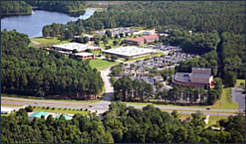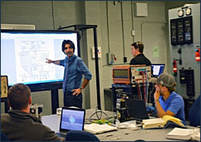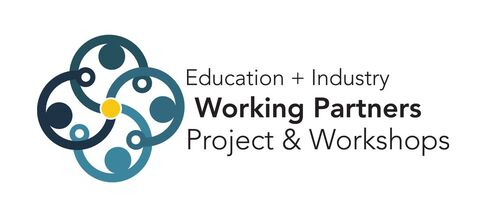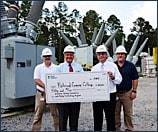|
Energizing Tomorrow’s Workforce: Creating Pathways to Electrical Utility Careers
ATE Project - Richmond Community College, Hamlet NC
Key Outcomes
- Constructed campus-based utility substation for training needs through industry support
- Secured millions of dollars in donated equipment, materials and funding
- Close to 100% job placement for graduates; starting salary $70K on average
- Developed initial partnership with local energy utility, expanded to multi-state, regional partnership network
Summary

In 2011, Duke Energy approached rural North Carolina’s Richmond Community College with an urgent need for substation and relay technicians. Employers were training new hires themselves in an attempt to fill jobs vacated by an aging workforce and were spending up to five years readying university engineering graduates for this work. Steve Lampley, a Senior Engineering Technical Support Specialist at Duke, suggested that Richmond Community College could create new industry-specific courses which could be combined with engineering and electronics courses already taught at the college to train technicians in half that time. With this, the College’s relationship with the electric utility industry was launched.
|
The College hired Mr. Lampley as the first full-time instructor for the nascent program and collaborated with industry experts to develop the Electric Utility Substation and Relay Technology Program (EUSRT) and the Associate in Applied Science degree. Mr. Lampley, hired as initial faculty member, leveraged his industry network and secured initial donations of $1 million in equipment resulting in the construction of a campus-based substation facility. Partnerships expanded to include national utility sector giants, many resulting in donations of equipment, materials or funding. These contributions are run though a non-profit within the College's foundation office so that they can be handled as donations by the donor and College. NSF ATE funding provided resources to continue to build the program and these relationships.
|

An example of such industry support is the College’s partnership with Doble Engineering, an industry leader providing equipment and software used to optimize system performance. Doble uses a lease model to provide clients with its technology, technical support, replacement parts, and software updates, and donated a full lease to Richmond’s program, permitting the program access as a fully licensed leasee. Doble has also installed cutting edge equipment at the College to test it "before it hits the field." Students thus gain exposure to the most current of technologies.
|
While not currently soliciting new partners, any company or utility that expresses an interest in collaborating is invited to visit the College and tour the program in a way that meets their expressed interests; this can include reviewing curriculum and assessments, visiting classrooms, meeting with students, touring the facilities, and/or meeting the program administrators and faculty.
The program is open enrollment and has a graduate placement rate of nearly 100%; as might be expected, the program is currently at capacity with a wait list. However, student retention from enrollment to degree stands only at roughly 50% ; as a result, the program will soon migrate to selective entry with supports in place for those not meeting minimum requirements and a focus on stronger pathways for regional high schools students. |
Most of the time, we'll start out with "Come on down here, and visit us. We'll take the time, we'll open our books, we'll show you what we've got and what we're doing." We let them talk with our students. Brian Terry Program Coordinator/Lead FacultyroPgram |
The program has expanded from its regional beginning to supplying technicians to a multi-state area and hopes to expand their service district even further. In addition, the program will be launching industry training programs to supply on-demand training to partner employees.
Impacts
- Program formation, continuation
Initial and on-going equipment and financial donations from industry partners made possible the construction and maintenance of an on-campus substation testing facility that is critical for the degree program - 100% graduate placement
On-going donations and industry involvement ensure students are trained on the latest equipment and workplace tools. This has contributed to a near 100% placement rate for graduates.
- Employer support
Employers are asked to provide feedback concerning graduates’ job readiness; this provides opportunities to solicit additional program support.
- Workforce succession
Benefits to industry include properly trained and well-skilled replacement technicians who are job-ready.
- Testing new equipment
Industry partners test new equipment at the College's substation benefiting both the companies and the students.
Challenges
- Initial challenges
Duke Energy approached the College with a willingness to partner and a vested interest in doing so; as a result, there were no initial partnership challenges.
|
"If we find we need something, we invite a representative [of a targeted company] to come see what we're doing, to try and solicit some equipment from them. [Sometimes] a wasted trip, but that's okay. Every partnership does not work. we try" Brian Terry Program Coordinator/Lead Facultyr |
- Non-Program Support Challenges
Difficulties in recruiting high paid industry workers for faculty positions, and ensuring internship opportunities were adequate in number were also mentioned as program challenges.
Implementation Strategies
|
"If you have a good partner, maintain that partnership but don't put all you eggs in one basket" Cynthia Reeves, internal evaluator |
- Communicate, communicate, communicate
Maintaining regular, ongoing, and open communication with industry, including transparency of curriculum and assessment, is noted as another key element to engaging industry for program support. Be open to their input and don't be afraid to ask for what you need. - Establish administrative support
Getting buy-in from your institution is critical to success. As noted by the staff of "It was key to have our president and CFO believe in this program from the start."
Additional Resources
Subject Information
|


